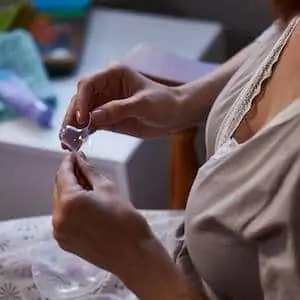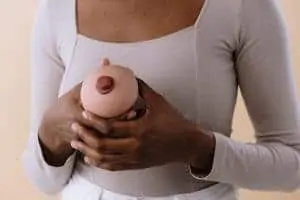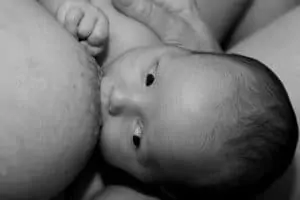Breastfeeding isn’t always rainbows and butterflies. It’s not uncommon for women to face damaged, painful nipples, or you might struggle with flat or inverted nipples. Latching on a hungry newborn is painful when your nipples are already cracked. That’s when you need to learn how to put on a nipple shield.
Nipple shields aren’t designed to be used continuously for your breastfeeding relationship duration, but it can help bring you much-needed relief and start the healing process. If you plan to use a nipple shield, you need to know how to apply it correctly for optimal success.
What is a Nipple Shield?
A nipple shield is a thin piece of silicone shaped to cover your nipple and areola, the area surrounding your nipple. It’s meant to look like an everted nipple.

The purpose of a nipple shield is to help moms struggling to breastfeed either due to pain or a latching problem. While they aren’t meant to be a permanent solution, breastfeeding mothers benefit from using one if they’re struggling and should give it a try before weaning their baby from the breast.
It’s crucial to note that nipple shields are meant to be a last resort instead of what you use all of the time. You should only wear one if you’re directed to by a lactation consultant or someone else who can help supervise. If used and worn incorrectly, it can cause more problems, such as low milk supply and weight loss for your baby.
When Should You Use a Nipple Shield
Moms should only use a nipple shield if they’re facing a problem breastfeeding. If your baby is latching well and your nipples aren’t cracked or bleeding, you don’t want to start using a nipple shield.
Having problems breastfeeding isn’t uncommon. If you face any of these challenges, using a nipple shield could be a great idea.
Sore, Cracked Nipples
The most common complaint that mothers have is sore or painful nipples in the early days of breastfeeding. Your nipples aren’t used to the abuse your baby is putting them through, so a shield can provide short-term relief.
Painful, cracked, or bleeding nipples are signs that something is wrong. The most common problem is that your baby has a bad latch. You can use a nipple shield until you figure out a solution to your sore nipples.
Flat, Short, or Inverted Nipples
You might not have realized beforehand, but many moms find out they have inverted, flat, or short nipples when you start breastfeeding. These issues don’t mean your baby can’t nurse! It just makes it a little harder for your baby to draw out your nipple. A nipple shield is a great solution!
Premature Babies
Prematurity can make it a bit harder to breastfeed because your baby might not have a fully developed natural sucking reflex. Also, their suckle might not be very strong yet. Using a nipple shield can help your baby latch and stay latched.
Tongue or Lip Ties
Many babies have tongue or lip ties, and they can make latching and staying latched harder for babies. Using a shield can help your baby get the best latch until you’re able to get help from a lactation consultant. You might want to get his tongue or lip tie clipped to reduce any pain associated with nursing.
Nipple Confusion
Sometimes, if your baby uses a bottle or pacifier, he can become confused when trying to latch onto your breast instead. A nipple shield helps your baby transition from breast to bottle with ease.
Pick The Right Sized Nipple Shield
Nipple shields aren’t one-size-fits-all. You need to wear one that is the proper size for you because a bad fit could block your milk flow. Shields come in a range of sizes, and your lactation consultant should be able to help you find the right size.
Here is how to find the right size nipple shield.
- Use a measuring tape and measure your nipple’s diameter, but be sure not to include your areola. You should measure straight across the middle of your nipple.
- Look for your mm reading. If your measuring tape doesn’t have mm, remember that 1 cm equals 10 mm.
- Please don’t get the shield with the exact measurement of your nipple; it’ll be too small. Typically, you want to size up. So, if your nipple measures 20mm, don’t get the 21mm, but the 24mm.
How Long Can I Use a Nipple Shield?
Using a shield all of the time means that your baby might be accustomed to breastfeeding with it. If you use it too often, you might have to wean your baby from the shield, and that can be problematic as well.
Pro tips:
You shouldn’t wear a shield for the entire feeding until an LC or pediatrician directed you to do so. Once your baby starts to nurse with the shield, remove it and try to latch your baby without the shield.
The goal is to use the shield only until your baby can latch onto the breast by himself and nurse efficiently. Each baby is different, so it might take only a few days for some babies or several weeks for others. After you reach this goal, you should discontinue the use of the shield.
Remember – plan to use a nipple shield as a short-term solution, not a long term plan.
6 Simple Steps to Put on a Nipple Shield for Breastfeeding
Using a nipple shield is easier than you might imagine! Try to avoid using a nipple shield for the first week of your baby’s life, but it’s sometimes unavoidable.
Here are the steps you should follow.
- Put the nipple shield in warm water for several minutes before using it. It helps to make the silicone more flexible.
- Use your hand to express a bit of breast milk, and put it on the nipple shield base. It helps to create the best seal while reducing chafing or rubbing issues.
- Stretch and spread the brim of the shield until it’s slightly, but not entirely, inverted. Then, place it on your nipple, putting as much as you can into the crown of the shield. Then, press down the edges of the shield around your areola, positioning the cut-out sections for your baby’s nose and chin.
- Your nipple shouldn’t touch the top of the shield; if it does, you have a size too small. There should be a small gap.
- Once you have the nipple shield secured on your breast, hand express a bit of breast milk into the tip of the shield. Not only does this help encourage a letdown, but it also encourages your baby to latch onto your breast. They get a quick taste of breast milk!
- Now that the shield is placed on your breast, aim your nipple towards the tip of your baby’s nose, encouraging your baby to open widely. This direction helps your baby latch correctly.
A good latch on a shield will look similar to a latch on your breast. Your baby should have pouty, outward lips that aren’t sucked inward. He should have more than just the nipple in his mouth, and your baby should have no trouble staying latched onto the shield.
Final Thoughts
Using a nipple shield seems intimidating, and learning how to put on a nipple shield can be frustrating at first. With practice, you can learn how to use one with ease and start working on whatever problems you have breastfeeding your baby.
Hey, this is Linda. My biggest accomplishment in life is being a mother of four children. Their current ages range from almost ten years old down to 20 months old.
I’m passionate about writing parenting articles because I understand so well all of the problems and trials you face as a parent. From breastfeeding woes to budgeting problems and behavior problems, along with everything in between, chances are I’ve faced it over the last ten years. Read more about Linda here.







